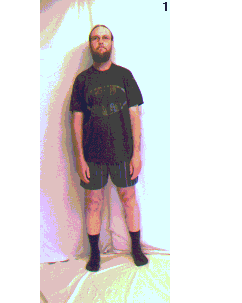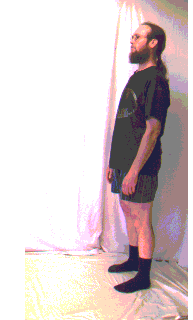|
Open a new browser window by clicking HERE
to take a look at great old photos of Li Li Da's Teacher, Master Wu Kung Yi, performing the Wu style of T'ai Chi Ch'uan! |
LESSON 1:
INTRODUCTION
PREPARATION
OPEN
T'AI CHI
GRASPING
BIRDS TAIL
SINGLE
WHIP
| please read the following text information while the images load on the page |
|
Preparation Open T'ai Chi Grasping birds tail Single whip
Preparation
for t'ai chi is as necessary to doing it 'right' as
is readying to bake good bread or
researching to be a good parent...if the yeast is too cold, the dough cannot
properly rise...if one does not adequately study child-rearing, one will probably
give to the world mediocre progeny. So give yourself
a moment before the set to prepare well.
I have found a wonderful online article describing Preparation;
you can click through on the following link to get to
it Energy
within us is centered at the tan tien
(roughly pronounced 'don dee-en'; one alt. sp.:
dantian), a place an inch or two below the navel, along the
ding jin axis
or thread. By focusing our minds attention at the tan
tienduring movement, we
can maintain a flowing, continuous balance-in-motion, moving
ourselves (and our seemingly separate constituent body
parts ~ arms, legs,
head, inner organs, etc.) as one, with less effort, which will yield
enormous
benefits to our health and our 'being'. As you may quickly find,
if, when you
are moving as one, you should momentarily THINK of something;
anything, Grasping birds tail (21 through 32) At this
point, the right arm swings away (21-23) to your right
side, ex-tending (bent elbow!) fully, palm facing out. (Left
hand remains in
place.)Your torso
will likewise bend away slightly to the right side with this motion,
as you continue to shift the weight onto your left leg almost completely
[W=
90L]. This frees up your right leg to swing out
in front of you (you are now
facing East
if you started out facing North)
(23-25); do this by lifting your right foot
(raise heel, then toe), then shifting it over to your left and easing it
down on its heel only.
(Try always to make the arms and legs
swing in slight
arcing motions, not straight lines or hard angles; round all of your movements
for optimal benefit.)
At
this point you are facing completely East. Notice that your left foot is
(25) at the perfect angle (45°) for support. Single
whip (32
through 36) Because
the essence of t'ai chi is about oneness and therefore continuity,
one thing I am not real clear on is where one named posture in the form
ends,
and where the next posture begins. This is in part because of the
evolution of postures and names for them down through the centuries; one
style evolved into another, those to, in turn, evolve again. So it
is that the style I have learned and now relate here is what I was taught
by several of the senior students of the late Li Lida. As with any
oral or non written tradition, though,
it is natural for some diversity of viewpoint on matters fundamental
amongst
Single whip begins :) by drawing your left foot further leftward
(lift heel up first, then toe) to a comfortable distance (don't over-do,
dont under-do) at a point where it is parallel with your right foot (both
feet are still at 45° angles,
pointing NE),
and the left toe lines up even on the floor with the instep of the
right foot (set toe down first, then heel) (32). Then, shifting
your weight to
your left [W= 60R] (33-36), draw your
left hand in that direction too, across the front of your face, with your
fingertips at eye level, pointing upward and
slightly to the right, your palm facing in. (31-32)
Keep your right hand (Remember to keep your knees and elbows at least slightly bent and your pelvis tucked in throughout the set.) (If at all possible, it is suggested
that someone read the text to you - or record it
on a tape and play it back - while
you slowly practice the form...and slowlyis
¹ Never position your knee past the tips of your toes; draw an invisible line from your kneecap down to the front tip of your foot. You have bent your knees too much if they go forward further than your toe tips--bad ding jin) go back ² In t'ai chi, we consider 8 radial axes: the four directions--N, S, E, W; and the four corners--NE, SW, SE, NW--for the purposes of the lesson page here, the set begins facing North. go back ³
Fist space/separates:
always leave a gap between your arms/hands and your
torso equal to the size of your fist--no touching your arms/hands
to your torso, generally. (You should have room to place your
fist between your torso and
The links back to the above footnote numbers will
only return you to |
do not over-do do not under-do
|
T'AI CHI CH'UAN breathing moving as one being grounded tan tien (center of balance) ding jin (common axis) continuity single weightednes double weightedness yin/yang duality bent knees and elbows fist space/separates moving on a curve moving slowly concepts and expand the list of fundamentals |
May I suggest the best way to see these
images in the days after
the lesson page has changed is to
'right click' on those images you want NOW
and click
'save image as', then save it to some
hard drive (the loads are BIG!)
You can also freely copy/paste/amend the
text. (But do not sell, please)
~ ~ special thanks ~ ~
to
Michael W and Shar'n
for making free cyberspace available
for MORE Playshop lessons at
www.caliban.net
NOW all of the Playshop lessons should
ALWAYS be available online
~ ~ ~
If the pictures stop animating on your
page, hit reload (refresh)
(I've even had to "clear memory cache" first, if
I interrupted initial page loading)

Above is a mirror (reverse) image of the
Right Hand Set, which means that if you
follow, or mirror, my movement on your monitor
you will be performing a Right Hand Set...
(T'ai chi is practiced from both sides)
When YOU practice t'ai chi, move slowly
(and hopefully less jerkily than this animation)
.
 The Thesame postures as they would be seen viewed from the East (your right) remember: this is a mirror image |
click>>>NEXT LESSON - 2<<<here
~ ~ ~ ~ ~
notes:
I made the T'ai Chi graphic images using a reverse image option
so that I could
video the Left Hand Set, then when it is viewed here on your
monitor, it appears as a mirror image of a
Right Hand Set, which you can emulate by following my movements. Most
T'ai Chi students only
learn the Right Hand Set, and it is a good way to start. One can practice
the opposite side movements
(Left Hand) by practicing the reverse of the image(s) above. I am fortunate
that the students who
instructed me at my t'ai chi beginning practiced both sides
of the set daily. By learning the left and
right versions (identical, just reversed) of t'ai chi, I believe one may gain
even more.
~ ~ ~ ~
~
more notes:
Please
let me know what you like here and what really bugs you here, too
TO EMAIL HERE PLEASE MANUALLY CHANGE 'AT'
TO '@'
Is there some aspect of the movement not made clear by the images
(or the text, for that matter)?? Please tell me, and if I cannot clarify
it with words I will try to make a new image to illustrate a way out
of that confusion.
~ ~ ~
~ ~
still more notes:
It is better by far to experience learning Tai Chi of any kind
in a group setting, primarily for two reasons. First, it's more fun! and
nothing is better for learning than sharing ideas and practice with individuals
who share the same interests. By having many artisans practice together,
this allows for an excellent source of useful feedback. More than
critically watching the moves as others do them, this also affords an opportunity
that is unparalleled: by standing in the center surrounded by more advanced
students, with every movement in every direction, the novice has a rotating
view of the form. This allows the newer student to follow all the
others, even as the plane of movement tangents onto a new direction. Turn
left, a senior student is in front to follow from; turn right, another teacher
is in view;
spin around 180° and, yep, you guessed
it.
Though learning Tai Chi from pictures, and (sometimes even worse) from text,
is not the best method to use...it is what I can offer. Some people
have little or no access to teachers or classes in their area; some have
little or no money for them even if they did exist; some folk are shy and
some may be to dis-eased to go to a class; it is for all these people (the
ones online, at least) and of course for the martial arts intellectuals
(you know who you are) that I make this meager presentation.
For anyone in or near (or just visiting) the
San Francisco Bay Area, please accept our invitation to join us in our VIRTUAL REALITY
PLAYSHOP
(real people), any Saturday morning from 8:45 a.m. to 9:45 a.m.
at 1819 10th Street, in Berkeley.
(The set usually begins @ 9:10 a.m. Saturday
Just take the outside stairs on the south side of Finnish Hall to the top
to get in--or take the disabled folks elevator inside--if you need it)
~ ~ ~
~ ~
finally! feedback
finally, your notes:
Scott, I HAVE FEEDBACK FOR YOU
and/or
I wanna get email when the lesson page changes :)
FEEDBACK FORM:
Only you yourself will know if you have stretched
your chi 'enough', 'too much', or even 'not enough'. What
we desire to achieve with T'ai Chi is
balance: to get there, moderation, not excess, is required.
~ ~ ~ ~ ~
Keep in mind while upon this new journey that we do it for
our health, for our joy, for our spiritual
reawakening...not to suffer more, but to complete ourselves
as beings, and rejoice of the universe.
~ ~ ~ ~ ~
With gratitude to Li Lida (1922-1982)
SPECIAL THANKS
to Ruth, David, Lydia, Michael G, Shar'n, Harold, Eileen, Robert,
and all of the other people who have helped me learn T'ai Chi...
injoy
heartLove!
BOOKMARK THIS PAGE
~FOR
EASY RETURN
this webpage was originally
created at
8:33 P.M. P.S.T., on Tuesday, July 14, 1998
nothing new here in this
part of the Universe since
November 27, 2006
at 4:55 P.M.
last updated on Monday, July 19, 2010 at 9:03 P.M.
P.S.T.
COPYWRONG © 1997-2010 swrichie ALL RIGHTS REVERSED
 copywrong
© 1998-2010 by
copywrong
© 1998-2010 by![]() swrichie for hand use creations
swrichie for hand use creations
![]()
ALL RIGHTS REVERSED
~ ~ ~ ~ ~
| we share some common strand in this universe...we | as one |